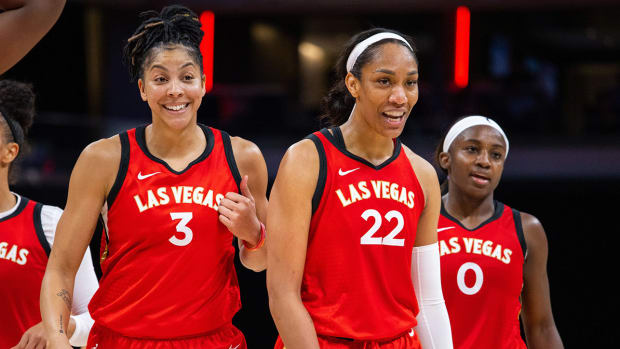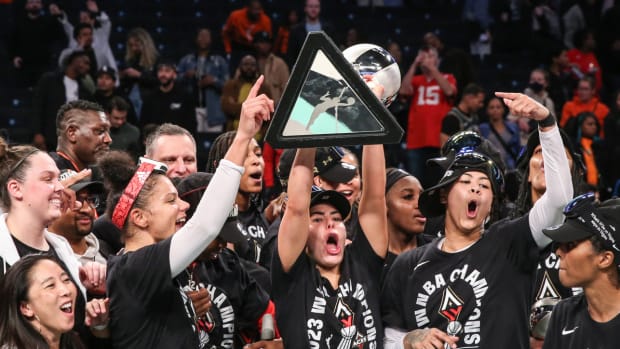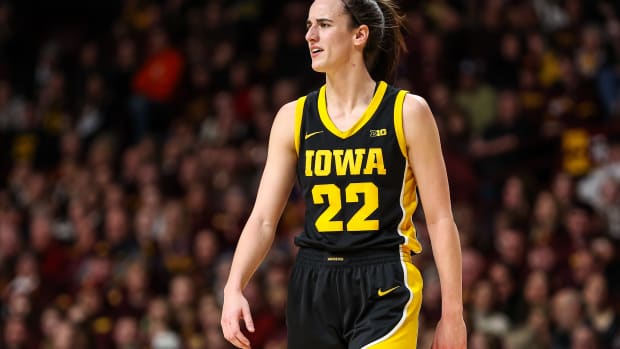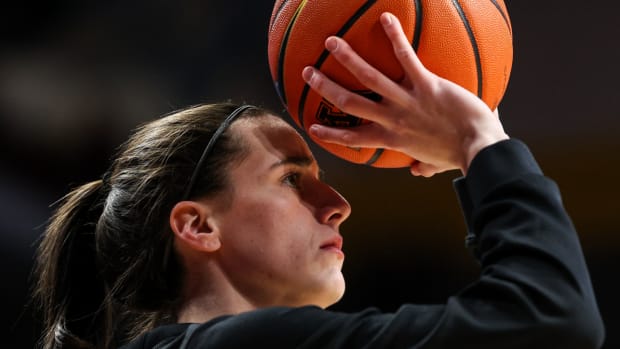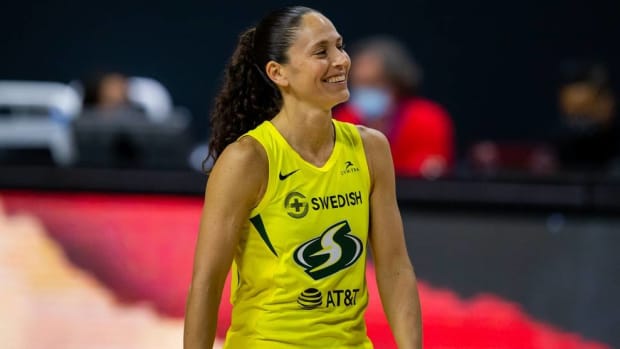That’s When I Knew: How WNBA No. 1 Picks Realized a Career in the League Was Possible
At 7:08 a.m. on April 15, Poda Collier tweeted a picture of a younger version of her daughter fast asleep in the back seat of a car. Her head rested on—what else?—a basketball. Approximately 12 hours later, Collier’s daughter Charli, now 21, became the 25th No. 1 pick in WNBA history.
“I was two years old in that picture laying on the basketball, and I’ve loved basketball ever since,” Collier told the media shortly after hearing her name called first. She is the 25th member of an elite group, the WNBA’s No. 1 pick club.
When did other first picks know the WNBA was their calling? We spoke to four generations of them about the moment they knew they wanted to play in the league.
Much like being a doctor, one would assume deciding to be an elite athlete comes at a young age. At least, that was the case for 2020 first pick Sabrina Ionescu. She and her twin brother, Eddie, were born Dec. 6, 1997, four months after the Houston Comets defeated the New York Liberty in the first WNBA championship game.
She had known since elementary school that she wanted to play professional basketball. Ahead of her draft, ESPN shared a home video of her giving a speech entitled “How My Basketball Dreams Began.”
“Every single poem that I had to write in elementary school had something to do with basketball and playing in the WNBA. So that was just one of a few that my dad recorded,” Ionescu says.
As the saying goes, ball is life. If her teachers were going to make her write poems and give speeches, why not write and talk about what she loved? Her passion started with the NBA.
“I just knew that there was a professional league and I couldn't play in the NBA,” she says. “So I was like, ‘O.K., I guess that's the WNBA. That's where my goals are. It's where I want to get to.’ ”
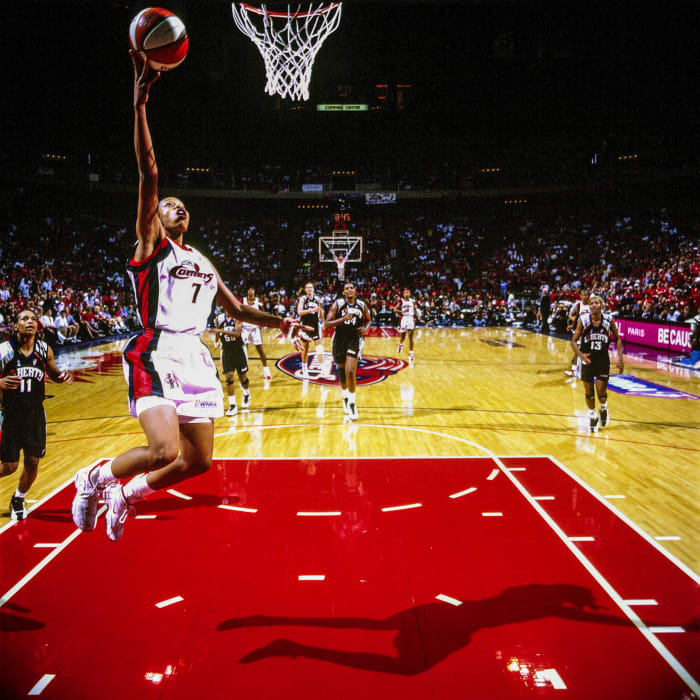
“I literally decided at the final hour that I was going to give the WNBA a chance,” Thompson says.
John W. McDonough/Sports Illustrated
Things were very different for Tina Thompson, the first No. 1 college draft pick in the WNBA. She played college basketball as a way to reduce the cost of her undergraduate degree en route to law school. By the time she was a senior at USC, the American Basketball League (ABL) was one season into its existence and the NBA announced it would begin the WNBA in the fall. These options were very new and unappealing to Thompson, or so she thought.
“I was preparing to take the LSAT because at that time, my life path was taking me to law school. I literally decided at the final hour that I was going to give the WNBA a chance,” Thompson says.
She changed her mind because of the opportunity to be a pioneer and create a path for the next generation. The league was backed by the NBA, something never seen in women’s professional basketball. This new model eased Thompson’s skepticism and empowered her and others to take ownership of the WNBA’s success.
“When we started when the WNBA started in 1997, it was about building a foundation that could last,” said Thompson. “The commitment to making connections with our fans, being in the community, and making sure that people knew the WNBA and had an understanding, it didn't just come from commercials. It came from the connections that the players themselves were making, and the network that we were building for people to come out and give us a chance.”
Unlike Ionescu, Thompson didn’t have women’s basketball in the United States as an option growing up. At best, Thompson could look forward to a USA Basketball career or playing overseas. She grew up making other plans.
“I had no intentions of playing professional basketball. When I went to USC, that was it for me, other than playing USA Basketball and possibly being an Olympian,” says Thompson. “I was going to law school. I was going to be an attorney. And my goal was to later be a Supreme Court justice.”
Thompson decided to participate less than 48 hours before the draft, held at the NBA headquarters in Secaucus, N.J. She arrived at her hotel around 6 a.m., with just enough time for a nap before heading to the studio. With a laugh, Thompson remembers her draft experience being a lot less glamorous than what is aired on ESPN these days.
“At that time, we had known where we were going to be picked,” she says. “It's so funny now to even look at it. I mean, if you pull up a picture of myself and [WNBA president] Val Ackerman, I was actually holding a practice jersey, not like an actual WNBA jersey, because the W jerseys had not been completed in production yet.”
The run-through and actual draft were cosmetic for Thompson, who’d already had conversations with a handful of teams, including her hometown Los Angeles Sparks, who had the third selection. Initially, Thompson thought she’d be drafted by the Sparks.
“I had already met with Rhonda Windham, who was the president–general manager of the Sparks at that time. They had invited me out to Laker games and all that kind of good stuff,” Thompson says. However, she also got a call from Comets head coach Van Chancellor telling Thompson he planned to take her first.
“I was sitting in the den with my siblings and my mom, and I just started bawling, crying. I was like, Houston, Texas? Are you kidding me? I don't want to live in Houston, Texas. So initially, I was so sad.”
The Angelino had been excited to play professionally in her hometown, the only city she’d ever known. With the help of her brother T.J, she eventually gained enough perspective so that moving to Houston was “a little less devastating.”
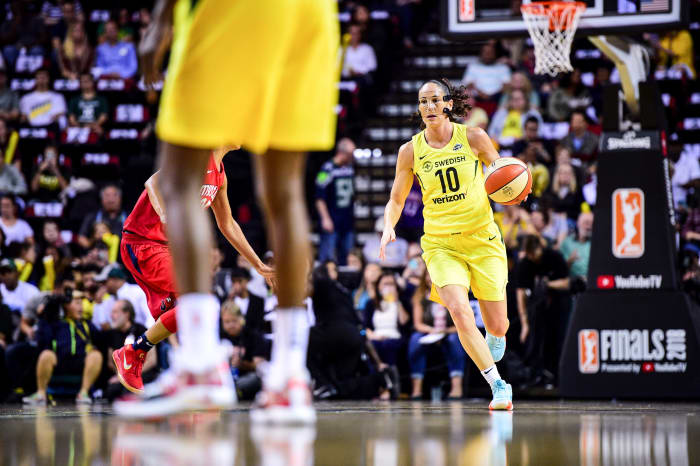
“I had heard about people having to go overseas, but I was young, so I didn't really understand that concept,” says Bird, who became a No. 1 pick in the WNBA.
Kohjiro Kinno/Sports Illustrated
As Thompson packed her bags to travel from Los Angeles to Houston, Long Island native Sue Bird was a junior at Christ the King. She helped win state championships during the school year and watched Liberty games in the summer.
“That was my first understanding of the whole idea that you could play professional basketball in America. I had heard about people having to go overseas, but I was young, so I didn't really understand that concept,” says Bird.
She eventually took her talents to UConn, where Hall of Fame coach Geno Auriemma groomed her for the bigger stage. In her junior year at UConn, Auriemma pulled Bird aside. He’d just returned from the 2000 Summer Olympics as an assistant for Nell Fortner’s USA Basketball staff. Seeing the U.S. win gold in Sydney convinced Auriemma that Bird could run with players of Olympic caliber.
“He put professional basketball, and especially the Olympic team, on my map for real,” recalls Bird.
She referred to the talk as more of a challenge than his coddling her ego. It was his way of motivating his junior point guard to work even harder. By the time Bird was drafted first in 2002, the Storm were two years into their existence and dead last in the Western Conference. Unlike Thompson, Bird had no communication with Seattle or any other teams before her draft.
“I had heard that I was probably going to go number one, but not until Val actually said my name was it official,” she says.
Later, she heard Storm coach Lin Dunn solidified Bird as her top choice at a USA Basketball practice. Dunn came to Colorado Springs and saw Bird, fresh off her 2002 NCAA title, holding her own with WNBA champion Lisa Leslie, All-Star Katie Smith, and the rest of the ’02 world championship team.
Flash forward, and Sue is the elder stateswoman among active No. 1 draft picks. A close second is her former UConn teammate and friend Diana Taurasi. Bird is one of the people who inspired Taurasi to pursue her professional career. Like Bird, the California native Taurasi grew up watching the WNBA.
In 2002, Taurasi won an NCAA championship with Bird and then watched her and Swin Cash go first and second in the draft weeks later. Watching her former teammates play professional basketball connected the dots from UConn to the WNBA.
“I remember that whole summer leading up to my junior year,” Taurasi told the media in February after signing a new multiyear deal with the Phoenix Mercury. “I just saw how real it was. It was actually people I played with, my teammates, my friends. To see them play on that big stage against the best players in the world.
“I think that’s when it really hit me. This is serious, and this is something that I want to do, and I’m gonna put everything I can into it.”
Lindsey Harding, the 2007 first draft pick out of Duke, was also used to seeing former teammates in the WNBA. Much like for Thompson, playing at Duke was as much about competitive basketball as it was about getting a good education.
Part of that mentality was born while watching the Comets at a sold-out arena growing up. The experience was mesmerizing and immediately prompted her to declare her intentions of playing in the WNBA.
“At that moment, I said, ‘I want to play the WNBA,’ and everyone's path, most of them at the time, their path was through college. I really took it serious then,” says Harding. By the following year, she began receiving recruiting letters from colleges, including from the University of Texas. It was a sign Harding was on the right path.
“That just became my goal,” she says. “To, you know, obviously do well in school. But for me to get to the WNBA, I had to play in college and do well.”
Harding landed a scholarship at Duke and led the team to two ACC tournament titles, four NCAA tournament berths and two Final Four appearances ahead of the 2007 draft. Duke was a formidable team and had landed players like Alana Beard and Monique Curry as top-three picks.
However, nobody went from the Blue Devils to first in the WNBA draft until Harding did it. Today, she works as an assistant coach with the NBA’s Sacramento Kings and was appointed head coach of the South Sudan women’s national team in April.
Over time, the labor of WNBA players has made stories like Ionescu’s or Collier’s possible. It is something Thompson thinks about a lot.
“We are our history, which means that this league goes as far as our actions, what we give, what we do to continue to move it forward,” she says. “And that takes work.”
Harding was given similar advice by Hall of Famer Nancy Leiberman. “She said, ‘I know you've only seen the league since you were a kid. That's all you know … but you are still a pioneer.’ ”
With each passing year, the WNBA grows within the women’s basketball space and beyond. Today, former players, champions, and first-round picks can be found everywhere. They continue to make ripples that reach the next generation of players, like Collier. Thompson coached WNBA players like Collier and Ariel Atkins at Texas and is the head coach at Virginia. Harding is one of a handful of woman coaches in the NBA and will now coach on the international stage. Sue Bird is one of four Olympians to found the media and commerce company Togethxr. Her 2004 Storm teammate Adia Barnes led Arizona women’s basketball to its first NCAA championship game this year.
Collier will take up the mantle for the No. 1 draft pick club. It’s an accomplishment her late father, Elliot Collier, believed his daughter would achieve. What he might not have dreamed is that his daughter would be coached at Texas by the first-ever first pick and be wearing a custom outfit designed by Sergio Hudson, who has dressed Beyoncé and Michelle Obama. He likely didn’t envision Thompson’s providing a special message to her former player on ESPN via video conference instead of at Nike headquarters as in years past.
It’s a new era for the WNBA, but the role of pioneer mustn't be forgotten. Among all the No. 1 picks we spoke to, none felt there was a special initiation or greeting shared among them. There were no special keys to a deluxe lounge or a secret handshake passed along.
However, each number one pick shared a determination to work just as hard, harder even, to prove they earned the right to be selected first. In that way, the passing of the torch is the expectation they will respect the honor and the obligations that come with being selected number one.
“I would say the same thing to the next draft coming in and especially the number-one pick: You are still a pioneer,” says Harding. “We’re still trying to bring this league to where it needs to be. Twenty-five years isn’t very long.”
As Thompson says, we are our history, indeed.
More WNBA:
• How One Hoodie Became the WNBA’s Defining Symbol














